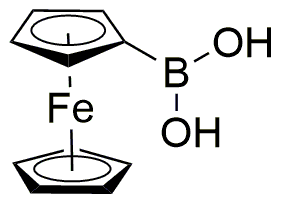Ferroceneboronic acid is widely utilized in research focused on:
- Organic Synthesis: This compound serves as a versatile building block in organic chemistry, enabling the formation of complex molecules through Suzuki-Miyaura coupling reactions, which are crucial for developing pharmaceuticals and agrochemicals.
- Materials Science: It is employed in the creation of advanced materials, particularly in the development of conductive polymers and nanocomposites, enhancing the performance of electronic devices.
- Bioconjugation: Ferroceneboronic acid is used in bioconjugation techniques, allowing researchers to attach biomolecules to surfaces or other molecules, facilitating drug delivery systems and targeted therapies in medicine.
- Sensor Development: This compound plays a significant role in the design of sensors, particularly for detecting glucose levels in diabetes management, offering a reliable and efficient method for monitoring health.
- Catalysis: It acts as a catalyst in various chemical reactions, improving reaction rates and selectivity, which is beneficial in industrial processes, leading to cost-effective production methods.
General Information
Properties
Safety and Regulations
Applications
Ferroceneboronic acid is widely utilized in research focused on:
- Organic Synthesis: This compound serves as a versatile building block in organic chemistry, enabling the formation of complex molecules through Suzuki-Miyaura coupling reactions, which are crucial for developing pharmaceuticals and agrochemicals.
- Materials Science: It is employed in the creation of advanced materials, particularly in the development of conductive polymers and nanocomposites, enhancing the performance of electronic devices.
- Bioconjugation: Ferroceneboronic acid is used in bioconjugation techniques, allowing researchers to attach biomolecules to surfaces or other molecules, facilitating drug delivery systems and targeted therapies in medicine.
- Sensor Development: This compound plays a significant role in the design of sensors, particularly for detecting glucose levels in diabetes management, offering a reliable and efficient method for monitoring health.
- Catalysis: It acts as a catalyst in various chemical reactions, improving reaction rates and selectivity, which is beneficial in industrial processes, leading to cost-effective production methods.
Documents
Safety Data Sheets (SDS)
The SDS provides comprehensive safety information on handling, storage, and disposal of the product.
Product Specification (PS)
The PS provides a comprehensive breakdown of the product’s properties, including chemical composition, physical state, purity, and storage requirements. It also details acceptable quality ranges and the product's intended applications.
Certificates of Analysis (COA)
Search for Certificates of Analysis (COA) by entering the products Lot Number. Lot and Batch Numbers can be found on a product’s label following the words ‘Lot’ or ‘Batch’.
*Catalog Number
*Lot Number
Certificates Of Origin (COO)
This COO confirms the country where the product was manufactured, and also details the materials and components used in it and whether it is derived from natural, synthetic, or other specific sources. This certificate may be required for customs, trade, and regulatory compliance.
*Catalog Number
*Lot Number
Safety Data Sheets (SDS)
The SDS provides comprehensive safety information on handling, storage, and disposal of the product.
DownloadProduct Specification (PS)
The PS provides a comprehensive breakdown of the product’s properties, including chemical composition, physical state, purity, and storage requirements. It also details acceptable quality ranges and the product's intended applications.
DownloadCertificates of Analysis (COA)
Search for Certificates of Analysis (COA) by entering the products Lot Number. Lot and Batch Numbers can be found on a product’s label following the words ‘Lot’ or ‘Batch’.
*Catalog Number
*Lot Number
Certificates Of Origin (COO)
This COO confirms the country where the product was manufactured, and also details the materials and components used in it and whether it is derived from natural, synthetic, or other specific sources. This certificate may be required for customs, trade, and regulatory compliance.


